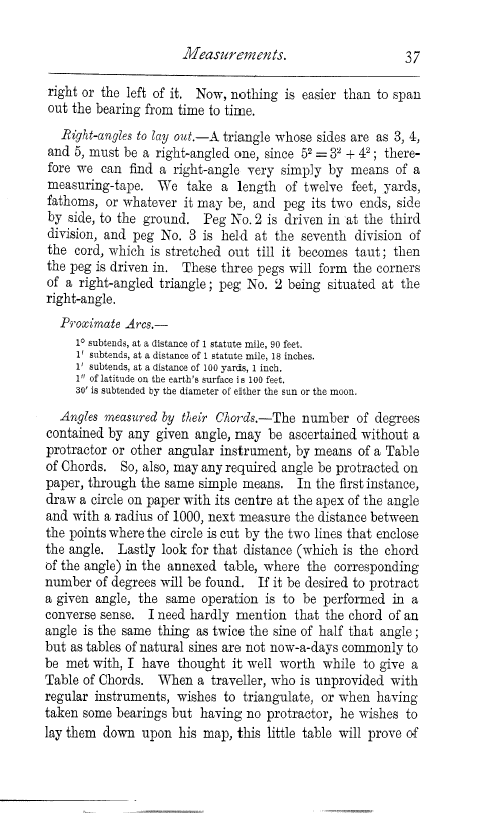Measurements. 37
right or the left of it. Now, nothing is easier than to span out the bearing from time to time.
Right-angles to lay out.-A triangle whose sides are as 3, 4, and 5, must be a right-angled one, since 52 = 32 + 42 ; therefore we can find a right-angle very simply by means of a measuring-tape. We take a length of twelve feet, yards, fathoms, or whatever it may be, and peg its two ends, side by side, to the ground. Peg No. 2 is driven in at the third division, and peg No. 3 is held at the seventh division of the cord, which is stretched out till it becomes taut ; then the peg is driven in. These three pegs will form the corners of a right-angled triangle ; peg No. 2 being situated at the right-angle.
Proximate Arcs.
10 subtends, at a distance of 1 statute mile, 90 feet.
1' subtends, at a distance of 1 statute mile, 18 inches. 1' subtends, at a distance of 100 yards, 1 inch. 1" of latitude on the earth's surface is 100 feet.
30' is subtended by the diameter of either the sun or the moon.
Angles measured by their Chords.-The number of degrees contained by any given angle, may be ascertained without a protractor or other angular instrument, by means of a Table of Chords. So, also, may any required angle be protracted on paper, through the same simple means. In the first instance, draw a circle on paper with its centre at the apex of the angle and with a radius of 1000, next measure the distance between the points where the circle is cut by the two lines that enclose the angle. Lastly look for that distance (which is the chord of the angle) in the annexed table, where the corresponding number of degrees will be found. If it be desired to protract a given angle, the same operation is to be performed in a converse sense. I need hardly mention that the chord of an angle is the same thing as twice the sine of half that angle ; but as tables of natural sines are not now-a-days commonly to be met with, I have thought it well worth while to give a Table of Chords. When a traveller, who is unprovided with regular instruments, wishes to triangulate, or when having taken some bearings but having no protractor, he wishes to
lay them down upon his map, this little table will prove of

